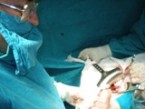В одной из европейских стран проанализировали больше 100000 операций по поводу паховой грыжи (все методики вместе и отдельно учитывали герниопластику по Лихтенштейну).
Как вы думаете, когда будет больший риск рецидива - при продолжительности операции менее 36 минут или более 66 минут ?
Прошу не гуглить, а просто высказать свое мнение.
Форум |
Сайт Surgeryzone |
Поиск "Медицина" |
Загрузить картинку |
Архив Surgeryzone |
Связь с администратором

Учитывая беcпрецедентное обострение отношений Украины и России, прошу не поднимать политические вопросы на форуме, он у нас медицинский. Все сообщения и темы такого рода будут сразу удаляться. Давайте не будем уподобляться всяким придуркам и будем жить дружно.
----------------
Илья Пигович
----------------
Илья Пигович
Зависимость риска рецидива паховой грыжи от продолжительности операции
Сообщений: 8
• Страница 1 из 1
Зависимость риска рецидива паховой грыжи от продолжительности операции
Любой вопрос по форуму можно задать по почте admin@surgeryzone.net
-

Илья Пигович - Сообщений: 6673
- Специальность: Хирург
- Откуда:
- Место работы:
- Год выпуска: 2005
- Одобрения от коллег: 607










Re: Зависимость риска рецидива паховой грыжи от продолжительности операции
Уважаемый коллега,вы просили высказать мнение. Мне представляется,что риск рецидива должен быть выше при быстрых пластиках (сетка не расправлена,мелкие кровотечения и т.д. и т.п.) Хотя,чем дольше оперируешь,тем травматизм близлежащих тканей увеличивается и,естественно увеличивается риск рецидива. Ну а если не выдумывать,то риск рецидива ,вероятно,одинаков.
Как молод я был! Как летал я во сне!
В года эти нету возврата.
Какие способности спали во мне!
Проснулись и смылись куда-то.
В года эти нету возврата.
Какие способности спали во мне!
Проснулись и смылись куда-то.
- Серый
- Сообщений: 865
- Специальность: Хирург
- Откуда:
- Место работы:
- Год выпуска: 1975
- Алекс
- Сообщений: 6100
- Специальность: не врач
- Откуда:
- Место работы:
- Год выпуска: 2015
- Одобрения от коллег: 393










Re: Зависимость риска рецидива паховой грыжи от продолжительности операции
Я думаю при долгих рецидивы выше. Ибо это или хирург не очень умелый и владеющий методикой или возникли технические трудности
Некоторые из года в год повторяют одни и те же ошибки и называют это клиническим опытом.
- КАА
- Сообщений: 1416
- Специальность: не врач
- Откуда:
- Место работы:
- Год выпуска: 1960
- Одобрения от коллег: 186








Re: Зависимость риска рецидива паховой грыжи от продолжительности операции
Думаю частота рецидивов в зависимости от времени операции на графике будет напоминать гиперболу, т.е. при слишком коротком времени будет высокой, затем снижаться и вновь увеличиваться при продолжительных операциях. В последних случаях возможно увеличение количества рецидивов будет связано с техническими трудностями во время вмешательства - отсюда и увеличение продолжительности операции.
-

Александр Петрушин - Сообщений: 3869
- Специальность: Хирург
- Откуда:
- Место работы:
- Год выпуска: 1982
- Одобрения от коллег: 561










Re: Зависимость риска рецидива паховой грыжи от продолжительности операции
Arch Surg. 2011 Oct;146(10):1198-203. doi: 10.1001/archsurg.2011.268.
National register study of operating time and outcome in hernia repair.
van der Linden W, Warg A, Nordin P.
Source
Department of Surgery, ?stersund Hospital, ?stersund, Sweden.
Abstract
OBJECTIVES:
To examine the relationship between operating time and reoperation for recurrence and other complications in groin hernia repairs.
DESIGN:
Observational population-based register study.
SETTING:
Data from the nationwide Swedish Hernia Register, which prospectively collects data from almost all groin hernia repairs performed in Sweden.
PATIENTS:
There were 123,917 primary groin hernia repairs recorded in the Swedish Hernia Register from January 1, 1998, through December 31, 2007.
MAIN OUTCOME MEASURES:
Relative risk of reoperation for recurrence and odds ratios for postoperative complications in 4 operating time groups.
RESULTS:
The relative risk of reoperation for recurrence of all patients operated on in less than 36 minutes was 26% higher than that of all patients with an operating time of more than 66 minutes (1.26; 95% CI, 1.11-1.43). Because the Lichtenstein procedure is the standard procedure in Sweden today, its results were also analyzed separately. In this homogeneous group, the difference was even more striking with an increased relative risk of 45% (1.45; 95% CI, 1.21-1.75). The odds ratio for infection and other postoperative complications increased with increasing operating time.
CONCLUSION:
A significant decrease in reoperation for recurrence with increasing operating time exhorts the hernia surgeon to avoid speed and to maintain thoroughness throughout the procedure.
http://www.ncbi.nlm.nih.gov/pubmed/22006880
National register study of operating time and outcome in hernia repair.
van der Linden W, Warg A, Nordin P.
Source
Department of Surgery, ?stersund Hospital, ?stersund, Sweden.
Abstract
OBJECTIVES:
To examine the relationship between operating time and reoperation for recurrence and other complications in groin hernia repairs.
DESIGN:
Observational population-based register study.
SETTING:
Data from the nationwide Swedish Hernia Register, which prospectively collects data from almost all groin hernia repairs performed in Sweden.
PATIENTS:
There were 123,917 primary groin hernia repairs recorded in the Swedish Hernia Register from January 1, 1998, through December 31, 2007.
MAIN OUTCOME MEASURES:
Relative risk of reoperation for recurrence and odds ratios for postoperative complications in 4 operating time groups.
RESULTS:
The relative risk of reoperation for recurrence of all patients operated on in less than 36 minutes was 26% higher than that of all patients with an operating time of more than 66 minutes (1.26; 95% CI, 1.11-1.43). Because the Lichtenstein procedure is the standard procedure in Sweden today, its results were also analyzed separately. In this homogeneous group, the difference was even more striking with an increased relative risk of 45% (1.45; 95% CI, 1.21-1.75). The odds ratio for infection and other postoperative complications increased with increasing operating time.
CONCLUSION:
A significant decrease in reoperation for recurrence with increasing operating time exhorts the hernia surgeon to avoid speed and to maintain thoroughness throughout the procedure.
http://www.ncbi.nlm.nih.gov/pubmed/22006880
Любой вопрос по форуму можно задать по почте admin@surgeryzone.net
-

Илья Пигович - Сообщений: 6673
- Специальность: Хирург
- Откуда:
- Место работы:
- Год выпуска: 2005
- Одобрения от коллег: 607










Re: Зависимость риска рецидива паховой грыжи от продолжительности операции
если бывает все классически, то соответственно и вреени меньше тратишь, а бывает ух как неудобный пациент!!!!соответственно продолжительность операции увеличивается, но при условии что все закончилось хорошо, то и рицидив минимален
-

ируля - Сообщений: 53
- Специальность: Хирург
- Откуда:
- Место работы:
- Год выпуска: 2007
- Одобрения от коллег: 15

Re: Зависимость риска рецидива паховой грыжи от продолжительности операции
Никогда не задумывался над таким вопросом, как время операции-:
1-цель-: сделать качественно, и тщательно;
2-не затягивать операцию, а для этого, на каждую операцию надо готовится, тогда получится качественно, и достаточно быстро.
3- скорость операции не должна влиять на ее качество!
4- а если смотреть в "корень проблемы"-:
мое мнение-:"Риск рецидива грыжи будет больше, при быстрой операции!"
"Грыжи быстро не оперируют!"
1-цель-: сделать качественно, и тщательно;
2-не затягивать операцию, а для этого, на каждую операцию надо готовится, тогда получится качественно, и достаточно быстро.
3- скорость операции не должна влиять на ее качество!
4- а если смотреть в "корень проблемы"-:
мое мнение-:"Риск рецидива грыжи будет больше, при быстрой операции!"
"Грыжи быстро не оперируют!"
"Стало жить лучше, стало жить веселей!"
-

dr.Viktor - Модератор
- Сообщений: 7552
- Откуда: Украина
- Специальность: Хирург
- Откуда:
- Место работы:
- Год выпуска: 1977
- Одобрения от коллег: 535










Сообщений: 8
• Страница 1 из 1
Кто сейчас на форуме
Пользователь просматривает форум: нет зарегистрированных пользователей